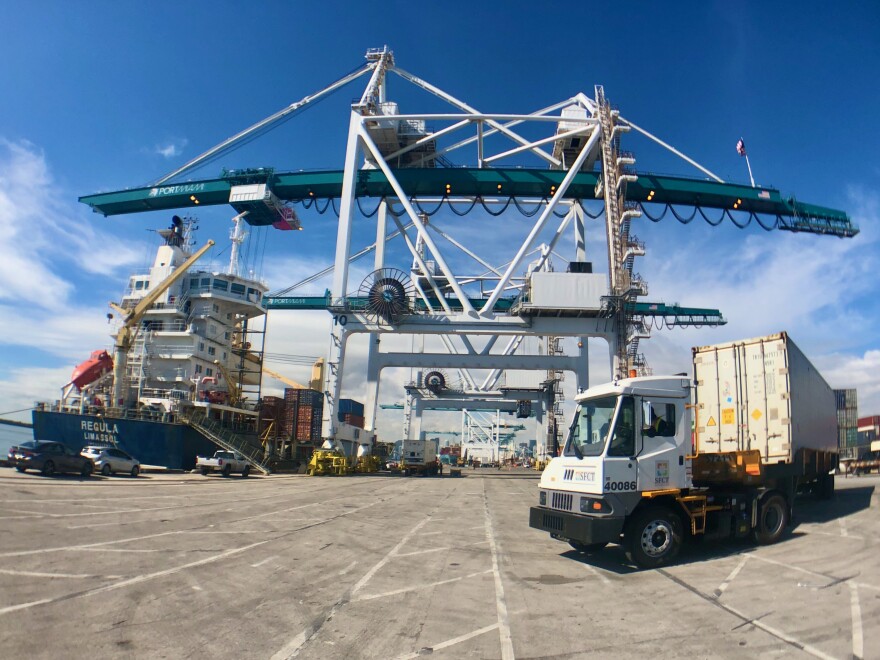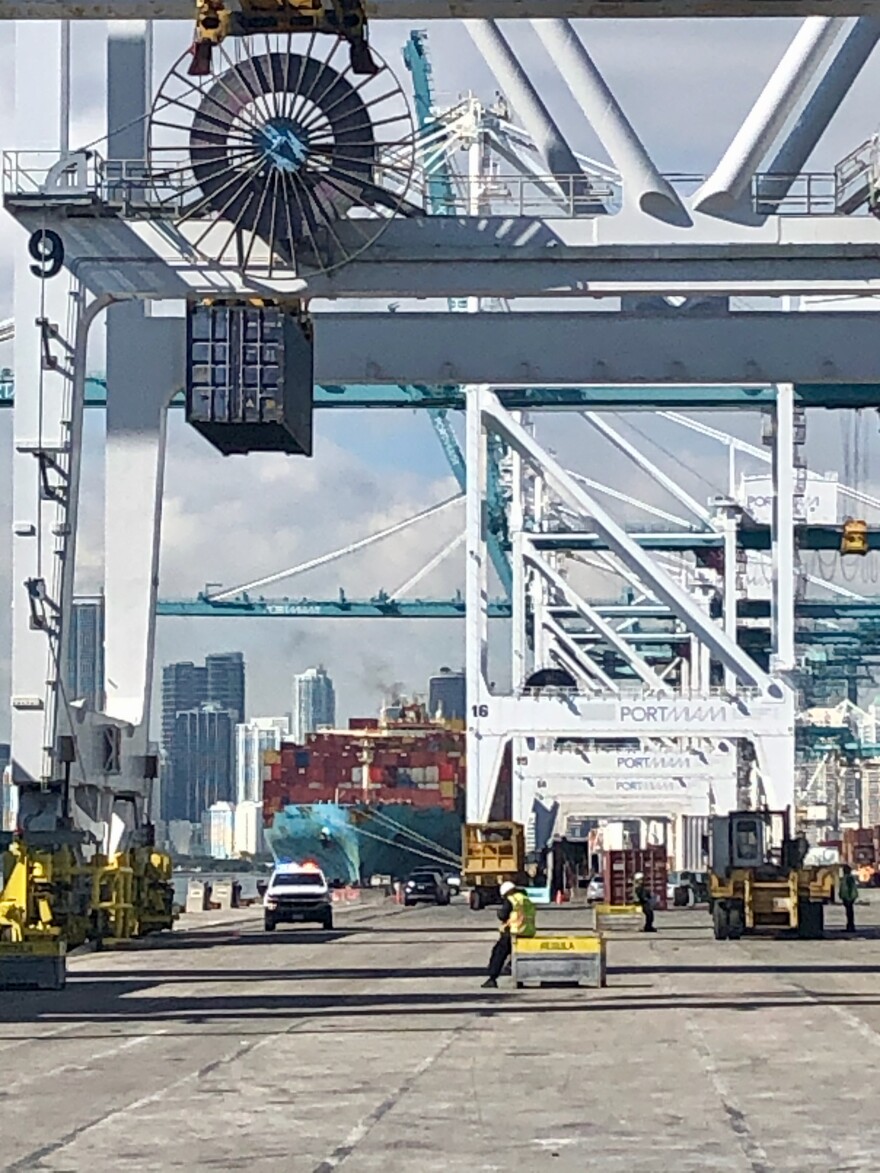PortMiami is a magnet for economic activity in normal times. It is at the heart of South Florida’s tourism industry with cruise ships and trade industry with cargo containers.
But the cruise ships are not sailing with passengers. Last week, Carnival Cruise Line announced it would not sail from U.S. ports like Miami until April 30 at the earliest. Royal Caribbean and Norwegian also have pushed back the earliest they may set sail again until late spring. And other cruise companies sailing out of PortMiami have delayed returning to the seas.
It makes for a quiet north side of the port. But the south side has been busy with record volumes of cargo.
You turn to WLRN for reporting you can trust and stories that move our South Florida community forward. Your support makes it possible. Please donate now. Thank you.
Steel shipping containers are stacked in terminal yards on the port creating neighborhoods of cargo three, four, five or more containers high. Trucks can line up by the dozens to pickup the boxes and drive them through the port tunnel, dropping 120 feet below sea level under Biscayne Bay, before connecting with I-395 and heading to warehouses, customers and storage yards across South Florida.
These short trips are called drayage and they represent one of the pinch points in the global trade chain.
Local trucking companies complain of delays on the port when picking up containers. They said drivers can wait more than three hours to have a container lowered onto their truck. The business thrives on speed and waiting in line means the drivers can make fewer trips in a day.
"A little bit of a challenge that is being overcome in terms of getting the containers out on particular days," is how port director Juan Kuryla described it to WLRN, particularly on the last day of free storage at the port's terminal operators. "You might have a rush of trucks coming in to pick up those imports [on those days], and that creates, from time to time, a little bit of congestion."
In December, owners of the stuff inside the cargo containers had to reserve truck drivers at least a week in advance, and the hours of at least one of the three companies operating a cargo terminal limited the time trucks could pick up the shipments, according to the Journal of Commerce, an trade industry news publication.
One custom office furniture maker in South Florida told WLRN of waiting almost three weeks to finally take delivery of a container of 4-foot by 8-foot sheets of laminate. It cost him nearly $4,000 in storage fees before the cargo finally made it off the port.
There are three independent companies operating cargo terminals at the port. The largest operator responsible for half of the volume, Seaboard, did not register any congestion problems during the last three months of the year when trade was at record levels, according to a port official.
A second terminal operator, Port of Miami Terminal Operating Company, was open over the past weekend for trucks.
"I love volume," said Kuryla. "I love increases in throughput. Can things be done a little bit quicker out of the other terminals? Right. Sure. You always have that balance."

Bigger ships through the expanded Panama Canal call upon Miami, after the bottom of the bay was deepened. And since 2015, rail has connected the port to the rest of the country. As the pandemic has pressed on, international trade has rebounded and the port has seen record traffic. But instead of cruise passengers it’s TEUs — shorthand for 20-foot equivalent unit, the standard measuring stick for shipping containers — crowding the dock.
October was the busiest month ever for cargo at the port with 107,000 TEUs moving in or out. That was 1.5% higher than the previous record month in October 2019.
It makes sense that October is a big month for ocean cargo. It is just before the holidays. Giant vessels from China arrive with manufactured goods in time for Christmas shoppers in the U.S. Smaller ships head out to the Caribbean and Latin America with hotels and resorts stocking up for winter tourists. But, of course, that wasn’t the case this October. Tourism is just a hint of what it would normally be. Instead, it is pent up demand from the slow spring and summer, and other factors feeding cargo traffic.
"We're seeing some some very nice numbers on the on the imports," Kuryla said.
He credits people spending money on their homes during the pandemic, pointing to imports of tile, marble and granite from Europe.
There was a thin layer of wispy cloud cover over the mainland and along Miami Beach last Thursday. It was late morning and two ships were along the wharf as crews loaded and unloaded containers. The Maersk Senang was the largest of the two. It was on its way to Portugal. A little further along the port was the Regula stopping before it left for Nassau.
It was positioned under two cranes. One was reaching on dock of the ship to grab a shipping container, hoisting it vertical, then bringing it onshore, hovering over a terminal truck, setting it on its bed before swinging back into the ship and the truck takes the steel box into a container yard where it will wait to be picked up.
A second crane was executing the same choreography but in the opposite order. A terminal truck drives up and waits for the crane’s spreader to settle onto the top of the box, grabbing it and lifting it up and out onto the deck of the ship.
It is an orchestration of power, moving tons of trading products on and off the port, fueling jobs here and the larger trade, logistics and transportation industries that rely on growing demand.

A third ship, the Astrid Schulte, had just been guided through Government Cut, the economic and maritime passageway into and out of South Florida. It had 1,000 TEUs to move before it departed Miami en route to Veracruz, Mexico.
This was the latest in a string of three busy days at the port last week. A day earlier a ship that started its journey in China and then South Korea called upon PortMiami with more than 2,000 TEUs to move. And on Tuesday, two ships — one from Italy and Spain, the other from South China, Singapore and the Mid-East — docked with almost 5,500 TEUs scheduled to be loaded or unloaded.
Cargo traffic has set records in recent months driven by imports. In the past three months, furniture has become the top item shipped to the port — most of it coming from China and Vietnam. T-shirts, socks, underwear and other clothing from Central America are also big commodities. And the port continues seeing more refrigerated containers with food coming in from overseas.
According to data firm World City, exports fell almost 20% in November compared to a year ago while imports jumped 13%. And with the value of the imports up, total trade at the port was up.


